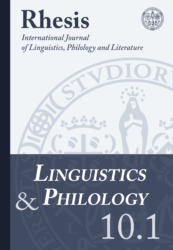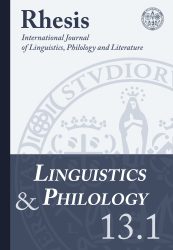 Linguistics and PhilologyVol. 10.1 - 2019
Linguistics and PhilologyVol. 10.1 - 2019Table of contents
| p. 5 | Qualche riflessione per la costituzione di un corpus di latino tardoPierluigi Cuzzolin Abstract This paper aims to present some observations on the methods used to assemble and organise collections of texts, i.e. the corpora of what are wrongly known as the dead languages. Although more technical aspects such as how to format or check the corpus are not dealt with here, representativeness, adequate corpus size and effectiveness are three essential features that must be taken into consideration for any late Latin corpus. |
| p. 19 | Las expresiones idiomáticas en la enseñanza/aprendizaje de ELE: un estudio sobre el nivel intermedio (B1/B2)Rosaria Minervini Abstract The studies carried out thanks to the lexical approach (Lewis 1993) testify to the importance of teaching the phraseological units for a better development of the communicative competence since they allow to learn groups of words. The lexical units are characterized —moreover— by their high frequency of use in conversation and by being used in multiple communicative situations, with various registers and in different types of texts. In this study, the focus will be on a concrete type of lexical unit, the idiomatic expression, which the Common European Framework of Reference (CEFR) suggests to present in the highest levels, specifically from C1; however, here it is proposed that, in the case of learners of Spanish whose mother tongue is Italian, or in the case of learners of neighboring languages, the teaching of these units would be already organized at an intermediate level (B1/B2), since our experience shows that if introduced into programming, learning takes place even at these levels. At first these lexical units will be described from a theoretical point of view, then some choices / presentation strategies will be exposed in the classroom and finally the corpus will be shown with the data of the exams results (ie, data related to learning) of the B2 level learners. These expressions are widely used by natives; hence the importance of teaching them so that the learner won’t just recognize them and use them, but also for him/her to fit into the linguistic community of the language they are learning. |
| p. 34 | Propositions d’interventions terminologiques dans le domaine du bien-être animal (français-italien)Francesca Chessa, Cosimo De Giovanni Abstract Animal welfare is a multidisciplinary domain of study. Because of the increasing importance of interdisciplinarity, laws are no longer drafted by only one person. Instead, an interdisciplinary team of specialists is needed as to ensure high quality in terminology and consequently conceptual coherence in the application of the law. The aim of this article is to analyse some French and Italian terms in a contrastive perspective which are ambiguous from the point of view of the denomination in one or both languages. The basic principle of our investigation is the need of adaptation of term formation not only to the corresponding concept (Depecker 2002) but also to the context of use which results in an implantation of the term from a social point of view through a further knowledge modelling (Auger 1999; Gaudin 2003). |
| p. 56 | La riorganizzazione del sistema verbale nello Slavo del Molise. Su alcune forme di futuroAntonietta Marra Abstract It is well known that the various forms of future tense tend to be very unstable in many languages of the world. In Indo-European languages it is assumed that this is due to the absence of an original form subsequently filled by different structures aimed at expressing this temporal deixis. These structures often added modal values – originally conveyed by the auxiliary forms used for the construction of periphrasis – to the temporal reference. The modal origin of these new temporal forms may also have determined their instability and continuous change. |
| p. 75 | Aspetti dell’interferenza sardo-italiano: il gerundio nell’italiano regionale di SardegnaRoberta Caddeo Abstract The aim of this paper is to outline the use of the gerund in the regional Italian variety spoken in Cagliari and related hinterland area. Starting from a corpus of spontaneous speech produced in informal colloquial situations, we firstly describe the aspectual values and the actional compatibilities showed by the periphrases “essere ʽbeʼ + gerund”, “rimanere ʽremainʼ + gerund” and “stare ʽstayʼ + gerund”. Then we analyse the semantical and syntactical properties of the gerund depending on perception verbs and in clauses introduced by “c’è presentativo”. The study has provided a first set of results which can reasonably be interpreted as an expression of contact-induced change of Italian by the influence of the local dialect (Campidanese Sardinian). |
| p. 113 | Atteggiamenti e usi linguistici di ragazze e ragazzi in Ogliastra e a CagliariIgor Deiana Abstract The paper draws the attention on the data collected during a sociolinguistic survey carried out in Ogliastra and in Cagliari. Aimed to contribute to the basic findings of previous studies focused on the vitality of minority languages and on the effectiveness of recent language policy, the survey has investigated the sociolinguistic dynamics of the two areas. The analysis of the data collected made it possible to assess the nature of some changes observed and their impact on linguistic repertoire. Starting with some general consideration on the multilingual Sardinian repertoire, focusing on gender, the contribution tries to discover if there are differences between male and female speaking in the two areas. The paper investigates how teenagers speak, how adults speak to them and the use of swear words and blasphemy. On the basis of the acquisitions made by gender studies and taking into consideration what has already been said by previous pieces of research on the Sardinian situation, this paper critically explores the data collected. Although the main expected trends are mostly respected, it has also been possible to identify some peculiar and innovative traits. In fact, by an attentive analysis of the respondents’ answer it has been possible to highlight some new tendencies. |
| p. 137 | Dal latino all’italiano: una storia di paroleMaurizio Trifone Abstract This essay offers an overview of the relationships that connect the Italian and Latin lexicon, highlighting the peculiarity of the Italian language in the context of Romance languages. The phonological proximity of Tuscan to Latin has favored the insertion of a vast number of learned words, creating a latinization of the Italian lexicon to an extent that is greater than for any other Romance language. In the formation processes of the Italian language, the influx of learned words played a role no less important than that played by the entry of popular words. Hereditary words are more rooted in areas of daily life and material culture; Latinisms have left a greater imprint on the abstract intellectual lexicon and have been of fundamental importance in the constitution of an international scientific lexicon, but they also deeply pervade the basic vocabulary. The language of ancient Rome has left its mark on the European lexicon because it was also the medium for introducing a conspicuous number of Greek words into Romance and non-Romance languages. Within Italian language, popular words and learned words are not two rigidly separated blocks: the linguistic reality, in fact, turns out to be more complex than these schematic distinctions because of the continuous relationship of interchange between the two nuclei traditionally identified with the learned and popular labels. The creation of a third category, that of half-learned words, only apparently solves the problem and confirms that the popular tradition and the learned tradition are clearly not separate channels. The essay highlights how the interweaving of words of different origin gives life in Italian to complex families of words, each of which presents a different story that is the result of crossings and migrations from one language to another. In particular, the study focuses on the analysis of a high number of allotropes, whose historical path, semantic development and phonetic evolution are outlined. Ample space is dedicated to the characters and phenomena of the Vulgar Latin lexicon: the loss of the less common synonyms, the disappearance of homophones, the replacement of short words with longer words or of generic words with specific and expressive words or of single words with syntagms, the substitution of diminutives for basic forms or frequentative and intensive verbs for simple verbs, semantic broadening and narrowing, and the coining of new verbs. A linguistic revolution of this magnitude was favored by the advent of Christianity: a religion that made the primacy of the least important person one of the cornerstones of its message, and which therefore operated a complete reversal of the social hierarchy could not fail to adopt a sermo humilis that was close to the language of the people and was thus easily understood by the faithful masses. The influence of Christianity is investigated through the examination of three guiding threads: Hebrew words that entered Christian Latin through Greek; words of Christian Latin derived from Greek; and semantic changes in Christian Latin. In this excursus the contribution of Latin to Italian is observed through the visual angle of words, of which historical events are reconstructed in an imaginary journey from the past to the present. |
Tags: adequate corpus size, allotropes, animal welfare, Antonietta Marra, Campidanese Sardinian, converb, corpus linguistics, Cosimo De Giovanni, effectiveness, etymology, Francesca Chessa, future tense, gender, gerund, harmonization of terminology, idiomatic expressions, Igor Deiana, implantation of the term from a social point of view, Italian, Italian lexicon, language, language change, language contact, Late Latin, Latinisms, legislative harmonization, lexical units, Maurizio Trifone, minority language, phraseology, Pierluigi Cuzzolin, representativeness, Roberta Caddeo, Rosaria Minervini, Sardinian, Sardinian regional Italian, Slavic of Molise, sociolinguistics, Spanish LE, teaching/learning, terminological interventions, Vulgar Latin

